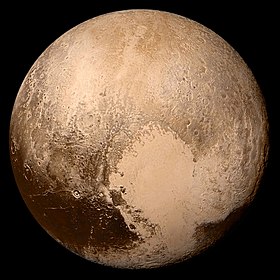Pluto

Full-disc view of Pluto in near-true color, imaged by New Horizons
|
|||||||||
| Discovery | |||||||||
|---|---|---|---|---|---|---|---|---|---|
| Discovered by | Clyde W. Tombaugh | ||||||||
| Discovery date | February 18, 1930 | ||||||||
| Designations | |||||||||
| MPC designation | 134340 Pluto | ||||||||
| Pronunciation | |||||||||
|
Named after
|
Pluto | ||||||||
| Adjectives | Plutonian | ||||||||
| Orbital characteristics | |||||||||
| Epoch J2000 | |||||||||
| Aphelion |
|
||||||||
| Perihelion |
|
||||||||
|
|||||||||
| Eccentricity | 0.2488 | ||||||||
|
|||||||||
| 366.73 days | |||||||||
|
Average orbital speed
|
4.67 km/s | ||||||||
| 14.53 deg | |||||||||
| Inclination |
|
||||||||
| 110.299° | |||||||||
| 113.834° | |||||||||
| Known satellites | 5 | ||||||||
| Physical characteristics | |||||||||
|
Mean radius
|
|
||||||||
| Flattening | <1% | ||||||||
|
|||||||||
| Volume |
|
||||||||
| Mass | |||||||||
|
Mean density
|
1.860±0.013 g/cm3 | ||||||||
| 1.212 km/s | |||||||||
|
Sidereal rotation period
|
|
||||||||
|
Equatorial rotation velocity
|
47.18 km/h | ||||||||
| 122.53° (to orbit) | |||||||||
|
North pole right ascension
|
132.993° | ||||||||
|
North pole declination
|
−6.163° | ||||||||
| Albedo | 0.49 to 0.66 (geometric, varies by 35%) | ||||||||
|
|||||||||
| 13.65 to 16.3 (mean is 15.1) |
|||||||||
| −0.7 | |||||||||
| 0.06″ to 0.11″ | |||||||||
| Atmosphere | |||||||||
|
Surface pressure
|
1.0 Pa (2015) | ||||||||
| Composition by volume | Nitrogen, methane, carbon monoxide | ||||||||
Pluto (minor-planet designation: 134340 Pluto) is a dwarf planet in the Kuiper belt, a ring of bodies beyond Neptune. It was the first Kuiper belt object to be discovered.
Pluto was discovered by Clyde Tombaugh in 1930 and was originally considered to be the ninth planet from the Sun. After 1992, its planethood was questioned following the discovery of several objects of similar size in the Kuiper belt. In 2005, Eris, which is 27% more massive than Pluto, was discovered. This led the International Astronomical Union (IAU) to define the term "planet" formally in 2006, during their 26th General Assembly. That definition excluded Pluto and reclassified it as a dwarf planet.
Pluto is the largest and second-most-massive known dwarf planet in the Solar System and the ninth-largest and tenth-most-massive known object directly orbiting the Sun. It is the largest known trans-Neptunian object by volume but is less massive than Eris, a dwarf planet in the scattered disc. Like other Kuiper belt objects, Pluto is primarily made of ice and rock and is relatively small—about one-sixth the mass of the Moon and one-third its volume. It has a moderately eccentric and inclined orbit during which it ranges from 30 to 49 astronomical units or AU (4.4–7.4 billion km) from the Sun. This means that Pluto periodically comes closer to the Sun than Neptune, but a stable orbital resonance with Neptune prevents them from colliding. Light from the Sun takes about 5.5 hours to reach Pluto at its average distance (39.5 AU).
...
Wikipedia
